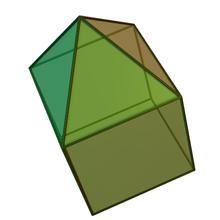Elongated square pyramid
| Elongated square pyramid | |
|---|---|
 | |
| Type | Johnson J7 – J8 – J9 |
| Faces | 4 triangles 1+4 squares |
| Edges | 16 |
| Vertices | 9 |
| Vertex configuration | |
| Symmetry group | |
| Dual polyhedron | self-dual |
| Properties | convex |
| Net | |
 | |
In geometry, the elongated square pyramid is a convex polyhedron constructed from a cube by attaching an equilateral square pyramid onto one of its faces. It is an example of Johnson solid. It is topologically (but not geometrically) self-dual.
Construction
The elongated square bipyramid is constructed by attaching two equilateral square pyramids onto the faces of a cube that are opposite each other, a process known as elongation. This construction involves the removal of those two squares and replacing them with those pyramids, resulting in eight equilateral triangles and four squares as their faces.[1]. A convex polyhedron in which all of its faces are regular is a Johnson solid, and the elongated square bipyramid is one of them, denoted as , the fifteenth Johnson solid.[2]
Properties
Given that is the edge length of an elongated square pyramid. The height of an elongated square pyramid can be calculated by adding the height of an equilateral square pyramid and a cube. The height of a cube is the same as the given edge length , and the height of an equilateral square pyramid is . Therefore, the height of an elongated square bipyramid is:[3]

The elongated square pyramid has the same three-dimensional symmetry group as the equilateral square pyramid, the cyclic group of order eight. Its dihedral angle can be obtained by adding the angle of an equilateral square pyramid and a cube. In an equilateral square pyramid, the dihedral angle between square and triangle is , and that between two adjacent triangles is . The dihedral angle between two adjacent squares in a cube is . Therefore, for the elongated square pyramid, the dihedral angle of the triangle and square, on the edge where the equilateral square pyramid attaches the cube, is:[5]
Dual polyhedron
The dual of the elongated square pyramid has 9 faces: 4 triangular, 1 square, and 4 trapezoidal.
| Dual elongated square pyramid | Net of dual |
|---|---|
 |  |
Related polyhedra and honeycombs
The elongated square pyramid can form a tessellation of space with tetrahedra,[6] similar to a modified tetrahedral-octahedral honeycomb.
See also
References
- ^ Rajwade, A. R. (2001). Convex Polyhedra with Regularity Conditions and Hilbert's Third Problem. Texts and Readings in Mathematics. Hindustan Book Agency. p. 84–89. doi:10.1007/978-93-86279-06-4. ISBN 978-93-86279-06-4.
- ^ Uehara, Ryuhei (2020). Introduction to Computational Origami: The World of New Computational Geometry. Springer. p. 62. doi:10.1007/978-981-15-4470-5. ISBN 978-981-15-4470-5. S2CID 220150682.
- ^ Sapiña, R. "Area and volume of the Johnson solid ". Problemas y Ecuaciones (in Spanish). ISSN 2659-9899. Retrieved 2020-09-09.
- ^ a b Berman, Martin (1971). "Regular-faced convex polyhedra". Journal of the Franklin Institute. 291 (5): 329–352. doi:10.1016/0016-0032(71)90071-8. MR 0290245.
- ^ Johnson, Norman W. (1966). "Convex polyhedra with regular faces". Canadian Journal of Mathematics. 18: 169–200. doi:10.4153/cjm-1966-021-8. MR 0185507. S2CID 122006114. Zbl 0132.14603.
- ^ "J8 honeycomb".
External links
- Weisstein, Eric W., "Johnson solid" ("Elongated square pyramid") at MathWorld.
- v
- t
- e
- elongated triangular pyramid
- elongated square pyramid
- elongated pentagonal pyramid
- gyroelongated square pyramid
- gyroelongated pentagonal pyramid
- triangular bipyramid
- pentagonal bipyramid
- elongated triangular bipyramid
- elongated square bipyramid
- elongated pentagonal bipyramid
- gyroelongated square bipyramid
- elongated triangular cupola
- elongated square cupola
- elongated pentagonal cupola
- elongated pentagonal rotunda
- gyroelongated triangular cupola
- gyroelongated square cupola
- gyroelongated pentagonal cupola
- gyroelongated pentagonal rotunda
- gyrobifastigium
- triangular orthobicupola
- square orthobicupola
- square gyrobicupola
- pentagonal orthobicupola
- pentagonal gyrobicupola
- pentagonal orthocupolarotunda
- pentagonal gyrocupolarotunda
- pentagonal orthobirotunda
- elongated triangular orthobicupola
- elongated triangular gyrobicupola
- elongated square gyrobicupola
- elongated pentagonal orthobicupola
- elongated pentagonal gyrobicupola
- elongated pentagonal orthocupolarotunda
- elongated pentagonal gyrocupolarotunda
- elongated pentagonal orthobirotunda
- elongated pentagonal gyrobirotunda
- gyroelongated triangular bicupola
- gyroelongated square bicupola
- gyroelongated pentagonal bicupola
- gyroelongated pentagonal cupolarotunda
- gyroelongated pentagonal birotunda
- augmented truncated tetrahedron
- augmented truncated cube
- biaugmented truncated cube
- augmented truncated dodecahedron
- parabiaugmented truncated dodecahedron
- metabiaugmented truncated dodecahedron
- triaugmented truncated dodecahedron
- gyrate rhombicosidodecahedron
- parabigyrate rhombicosidodecahedron
- metabigyrate rhombicosidodecahedron
- trigyrate rhombicosidodecahedron
- diminished rhombicosidodecahedron
- paragyrate diminished rhombicosidodecahedron
- metagyrate diminished rhombicosidodecahedron
- bigyrate diminished rhombicosidodecahedron
- parabidiminished rhombicosidodecahedron
- metabidiminished rhombicosidodecahedron
- gyrate bidiminished rhombicosidodecahedron
- tridiminished rhombicosidodecahedron
 | This polyhedron-related article is a stub. You can help Wikipedia by expanding it. |
- v
- t
- e

























